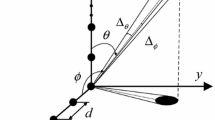Abstract
A smoothing algorithm for estimating the shape of a circular antenna from boundary observations is described. We consider a homogenized static antenna model, consisting of a single partial differential equation with mixed boundary conditions. An exact expression is derived for the smoother, and a suitable approximation is calculated. An FFT based implementation is found to be computationally efficient. Simulation results for 8, 16, 32 and 64 sensors are given, indicating a point of diminishing returns in adding more sensors.
Similar content being viewed by others
References
A. Krener, “Acausal Realization Theory, PartI: Linear Deterministic Systems,”SIAM Journal of Control and Optimization, vol. 25, 1987, pp. 499–525.
A. Krener, “Reciprocal Processes and the Stochastic Realization Problem for Acausal Systems,” inModeling, Identification and Robust Control, C. I. Byrnes and A. Lindquist, eds., Amsterdam: North-Holland, 1986.
M. B. Adams, A. Willsky, and B. Levy, “Linear Estimation of Boundary Value Stochastic Processes—Part 1: The Role and Construction of Complementary Models,”IEEE Transactions on Automatic Control, vol. AC-29, no. 9, 1984, pp. 803–810.
M. B. Adams, A. Willsky, and B. Levy, “Linear Estimation of Boundary Value Stochastic Processes-Part II: I-D Smoothing Problems,”IEEE Transactions on Automatic Control, vol. AC-29, 1984, pp. 811–822.
H. L. Weinert and U. B. Desai, “On Complementary Models and Fixed Interval Smoothing,”IEEE Transactions on Automatic Control, vol. AC-26, 1981, pp. 836–867.
A. Bagchi and S. I. Aihara, “Smoothing and Identification for Random Fields,”Advances in Communication & Control Systems, N. DeClaris, ed. Optimization Software, New York, 1988.
A. Bagchi and H. Wesdijk, “Smoothing and Likelihood Ratio for Gaussian Boundary Value Processes,”IEEE Transactions on Automatic Control, vol. 34, 1989, pp. 954–962.
G. Rodriguez and R. Scheid, “State and Model Error Estimation for Elliptic Systems: Applications to Large Antenna Static Shape Determination,” Proceedings of Workshop on Applications of Distributed System Theory to the Control of Large Space Structures, July 14–16, 1982, Jet Propulsion Laboratory, Pasadena, CA.
A. V. Balakrishnan,Applied Functional Analysis, second edition, New York: Springer-Verlag, 1981.
Author information
Authors and Affiliations
Rights and permissions
About this article
Cite this article
Leland, R.P. Shape estimation of a circular antenna from observations on the boundary. Multidim Syst Sign Process 7, 53–63 (1996). https://doi.org/10.1007/BF02106106
Received:
Revised:
Issue Date:
DOI: https://doi.org/10.1007/BF02106106




